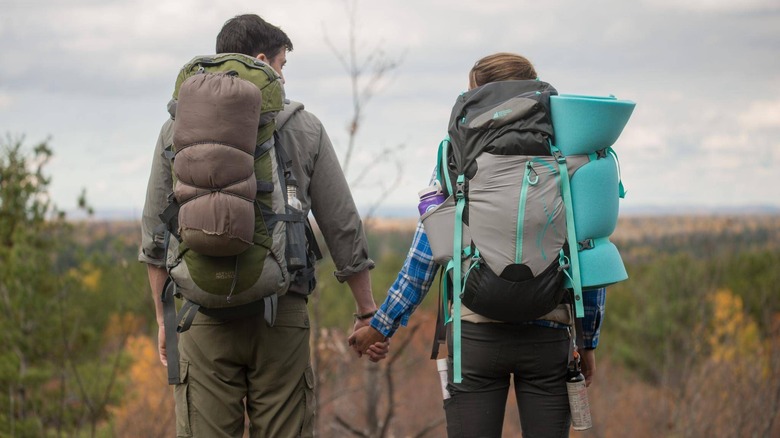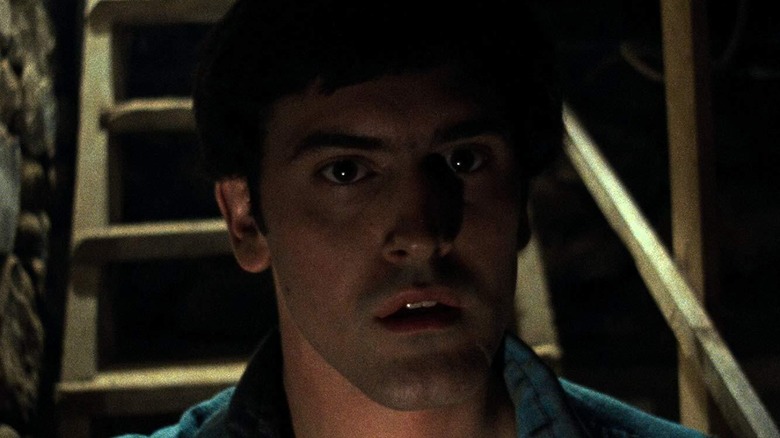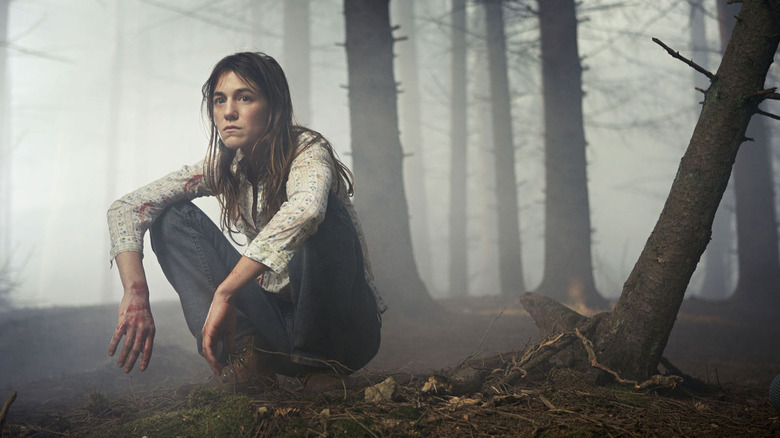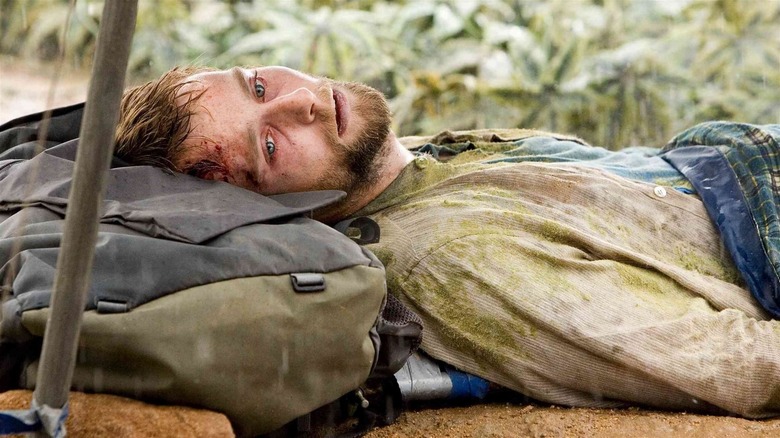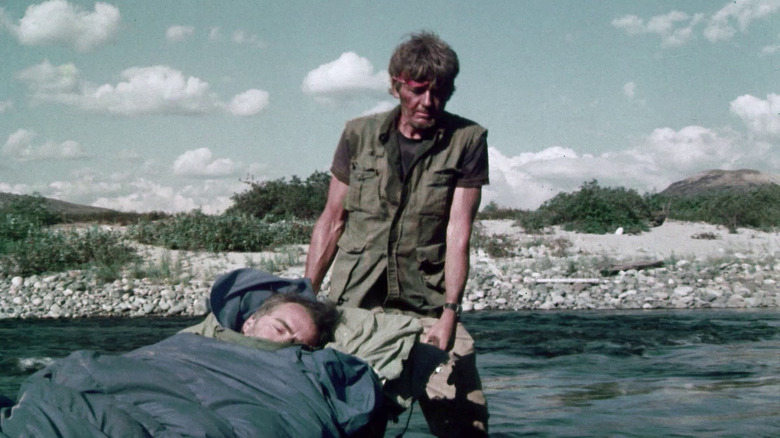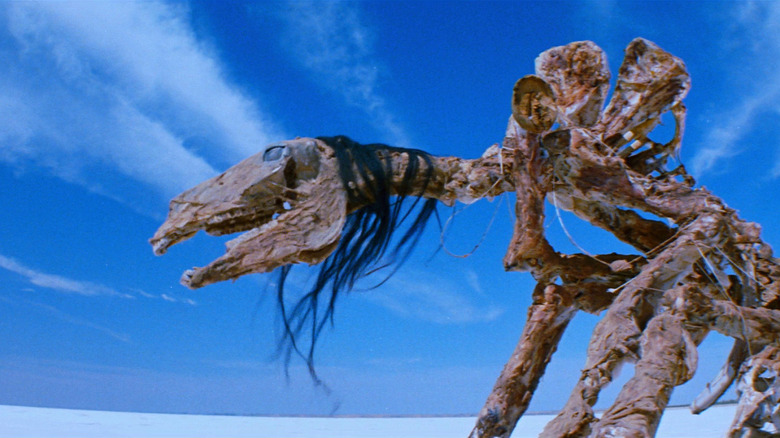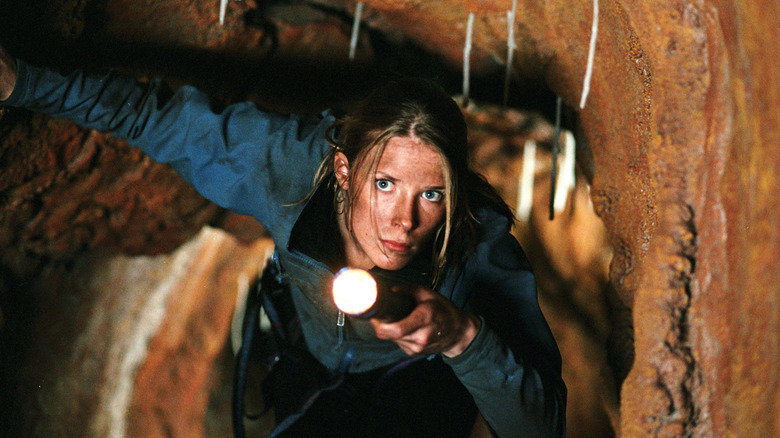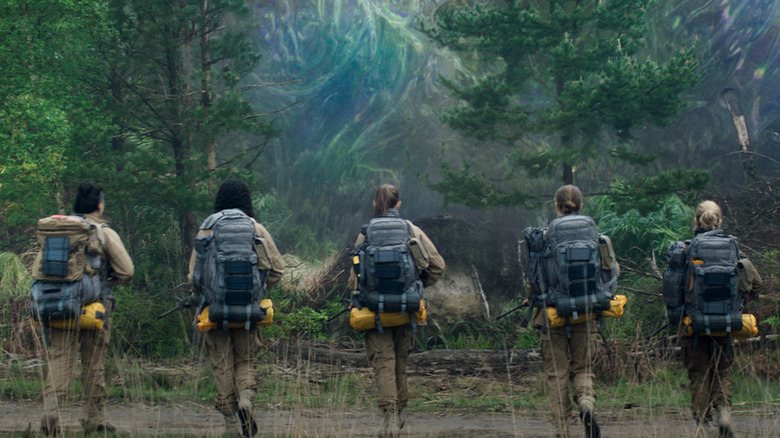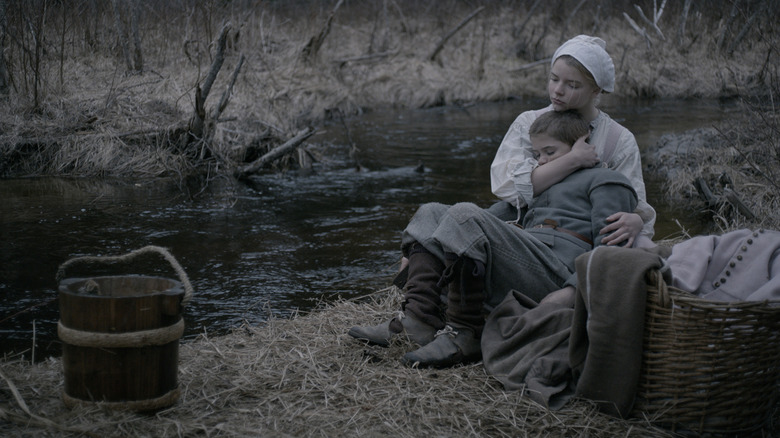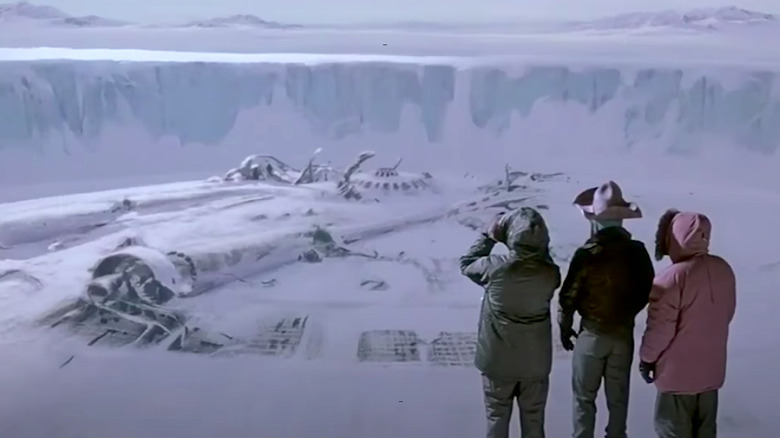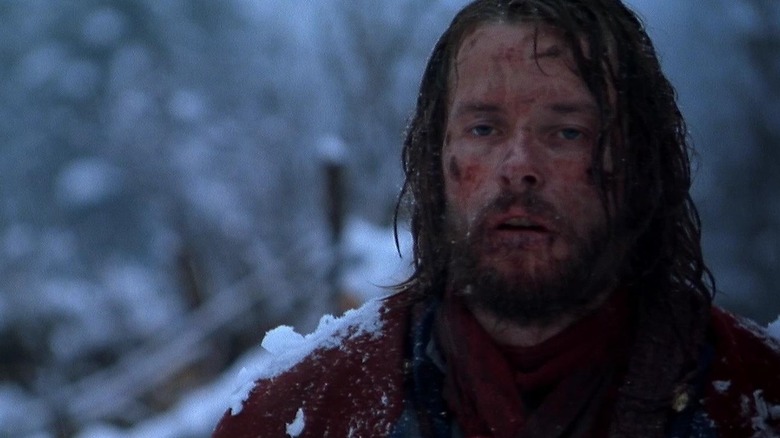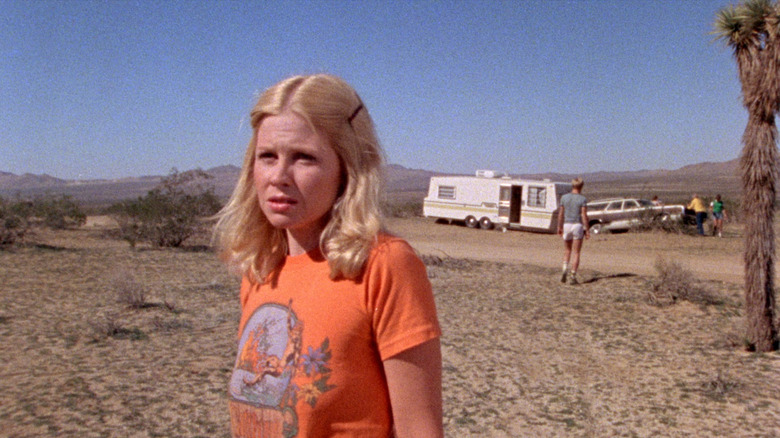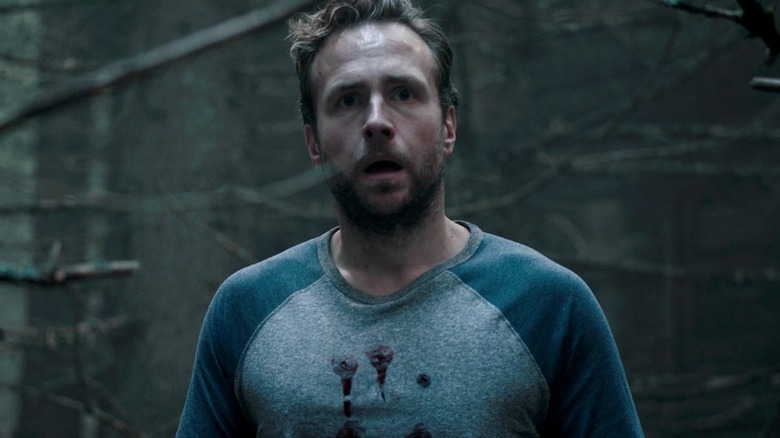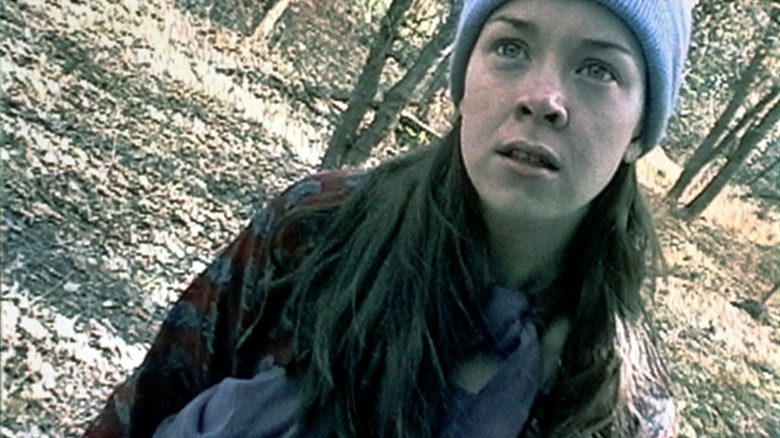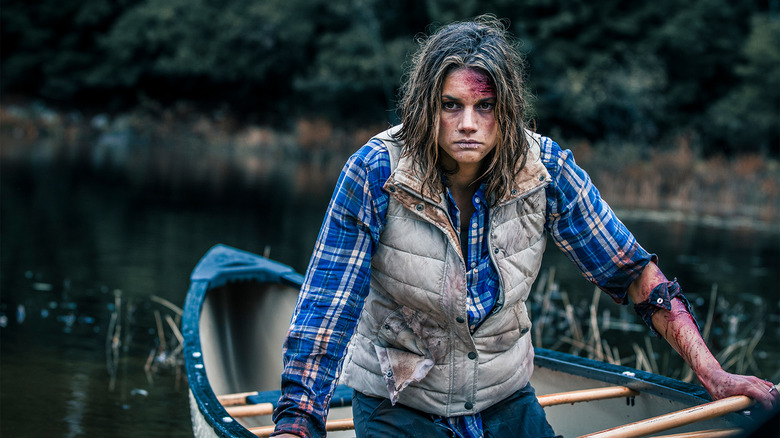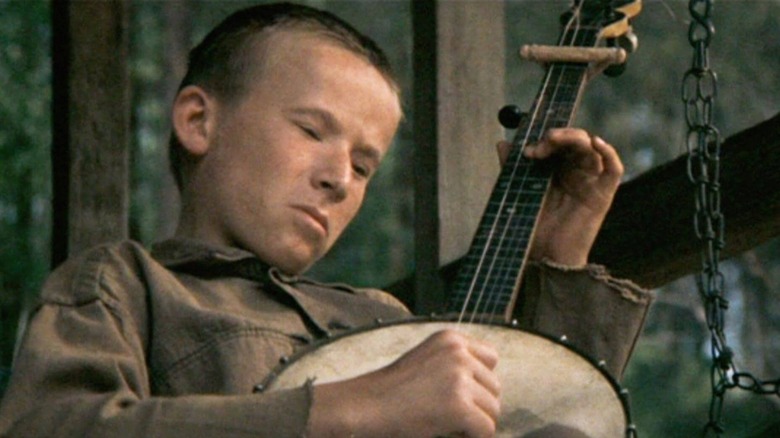The 15 Best Wilderness Horror Movies, Ranked
Nature is healing. Or at least it can be; a quiet escape from busy city life, a means of disconnecting from the chaos of daily routines, the promise of peaceful stillness and relaxation. But the great outdoors can also kill you in an instant if you're not careful or disrespect your surroundings. Things can switch from serene to scary at the drop of a hat if you're not careful, and sometimes even if you are. Where there's wilderness, there's the potential for true terror, and these movies understand that better than most.
But what is it that makes the wilderness such great fodder for horror? And what qualifies as a wilderness horror movie? According to the /Film horror brain trust, wilderness horror must involve either the absence or disintegration of social structures and societal constructs as we are familiar with them in day-to-day life while set somewhere in nature that's well off the beaten path. Being in nature is as much of a threat as what lurks in the darkness, behind a tree, or in a cave. Whether that's a black bear, a family of mutated cannibals, a mother's grief and rage, the Necronomicon, or the elements themselves doesn't matter — it all qualifies.
This list comprises some classic horror fare, lesser-known Canuxploitation gems, indie darlings, and heavy hitters alike. Here are the 15 best wilderness horror movies.
15. The Evil Dead (1983)
To borrow a phrase from Joe Bob Briggs, Sam Raimi's "The Evil Dead" is the original spam-in-a-cabin flick. Be it a sleepaway camp or a rustic summer jaunt, most people have spent at least a week or two in a wooded getaway. Ideally, it's a cozy escape from the rat race that allows burned-out individuals to hit the reset button by communing with nature. But it can be less than ideal if the owner of said getaway has left behind the Egyptian Book of the Dead and a recording of an incantation that summons evil, possession-happy spirits.
The rural Tennessee setting of "The Evil Dead" is integral to the film's gory, gonzo power. The cabin is accessible only by bridge, which gets destroyed early on. This is a worst-case scenario that's always lingering in the back of one's mind when they drive an hour or so into a forest to wall themselves off from the outside world. What if a hasty retreat is unexpectedly required, and the path back to the civilized world is blocked? As Raimi ramps up the gooey goings-on inside the cabin, it's the simple notion that there is no immediate escape that jars the hell out of the audience. Bruce Campbell and his buddies have to run this canted-angle gauntlet until dawn. (Jeremy Smith)
14. Antichrist (2009)
Lars Von Trier's "Antichrist" is a bizarre twist on the biblical story of Adam and Eve, though their Eden eventually becomes a total nightmare. In the 2009 film, an unnamed couple played by Charlotte Gainsbourg and Willem Dafoe suffer unimaginable loss when their young son dies in a tragic accident. The mother is overcome with grief, and her husband, a therapist, decides to try and help her heal by himself. The two go out to a beautiful cabin in the woods to work through her pain, but it seems that there's something sinister lurking in the scenic forest.
Throughout the course of the movie, Dafoe's character is visited by three different creatures of the forest that serve as harbingers of his eventual doom: a crow, a deer, and a fox. As his wife grows more possessed by the wild evil inside of her, the natural world around him becomes more dangerous. In one of the film's most memorable scenes, the pair have violent intercourse beneath a tree, and the tree's roots intertwine unnaturally with the couple's limbs.
In the Bible, Eve is responsible for all evil being unleashed upon the world, and in "Antichrist," Gainsbourg's character is similarly a conduit for the darkest parts of humanity. She becomes convinced that women are the source of evil, and the woods seem to react to her beliefs. Witchy women and the wilderness have been entangled in our collective consciousness for centuries, but "Antichrist" brings those fears of the unknown to the modern age. (Danielle Ryan)
13. The Ruins (2008)
Based on screenwriter Scott Smith's punishing novel of the same name, "The Ruins" follows two American couples on a vacation to Mexico, where they join some German tourists looking to find a lost brother who was working on an archeological dig in the Mayan ruins. When the group makes it to a temple on their search, they are ambushed. It seems as if the greatest threat to their lives are the armed Mayan villagers, but after Amy (Jena Malone) accidentally steps on a vine, it's immediately apparent that the true danger lurks in the jungle that surrounds them all.
Directed by Carter Smith, "The Ruins" feels like someone watched the nature-run-amok scene from "Jumanji" and decided to turn it into a horror movie.
The vines move throughout the characters like an infectious disease, forcing all of them to mutilate their own bodies in an attempt to cut out the tendrils. Limbs are amputated and mercy killings become a humane necessity. The vines creep through wounds, suffocate like snakes, rip flesh off the bone, and even imitate sounds to draw in prey.
"The Ruins" is a ruthless movie with some extremely graphic moments. It also serves as a great reminder that tourists have no business messing around with the sacred grounds of Indigenous peoples. (BJ Colangelo)
12. Rituals (1977)
Peter Carter's "Rituals" came out five years after "Deliverance," with just enough distance between the two for it to avoid being widely considered a total knock-off. It's true that the Canadian production isn't just a northern "Deliverance," but its basic premise follows a similar path. Five city-slicker surgeons, led by Hal Holbrook's Harry, head into the Northern Ontario wilderness only to discover that someone is after them. From here, though, "Rituals" charts its own course, and it's a uniquely frightening one.
Like several entries on this list, "Rituals" shows its age in a few ways. The script is often inadvertently dorky, as when one friend memorializes another as "such a gentle boob." Plus, its only currently available streaming version seems to be a grainy 35mm transfer that makes it look like a "Blair Witch"-style documentary. Yet despite all this, "Rituals" genuinely unnerves by mixing natural obstacles with man-made terrors. Whoever is hunting these men is taunting them, setting up murder scenes that call to mind their surgical work, and making their time in the wild a living hell. The movie ultimately proves itself an original with a bleak third act that pulls zero punches and features a great performance by Holbrook. (Valerie Ettenhofer)
11. Razorback (1984)
The Australian horror movie "Razorback" is a set of memorable contradictions. The story about a massive wild boar terrorizing newcomers in the Outback is at once beautifully filmed and cornily executed. In its gut-wrenching opening scene, a man loses his grandson to a wild boar attack and weeps at length outside his burning house. In another, more hallucinatory moment, an unseen boar that seems as if it must be the size of a god takes a chomp out of a second man's house, comically removing a whole corner wall to leave him looking like he's on a sitcom set. Together, the silly practical effects and gorgeous cinematography of "Razorback" create the feeling of a vivid dream, one that's worth getting lost in for 91 minutes.
"Highlander" filmmaker Russell Mulcahy brings a distinctive cinematic eye to "Razorback," and while it's far from perfect, it's certainly among the best-looking nature horror films out there. Its beauty belies its danger, just like the Australian Outback. Real reports of wild animals carrying off children, including an infamous one in 1980, make this a disturbing and effective setting for a horror film. After all, there's nothing scarier than a paradise that turns into a nightmare. (Valerie Ettenhofer)
10. The Descent (2005)
Years before Neil Marshall was crafting episodes of "Game of Thrones," he was sitting in the director's chair on original horror films like "Dog Soldiers" and "The Descent." In the latter, Marshall presents a harrowing wilderness story centered on six women who go cave diving only to find themselves trapped in dark, dangerous caverns inhabited by cannibalistic humanoid monsters. "The Descent" is a masterclass in claustrophobic horror, as characters try to condense and contort their bodies to seek safety, while the stone walls that surround them are always at the risk of crumbling around them.
Shauna Macdonald stars as Sarah, who upon losing both her husband and daughter in a terrible accident, joins her friends on this thrill-seeking expedition in the hopes that this will help her move forward from her immense grief. Even without the threat of bloodthirsty cave dwellers, it would be unlikely for the average person to survive the elements of a cave system on its own, which makes "The Descent" a fantastic wilderness horror film. But as much as "The Descent" is about defying the odds and making it out of the caves alive, it's also about the complexities of female friendships. (BJ Colangelo)
9. Annihilation (2018)
The Shimmer in Alex Garland's horror/sci-fi triumph "Annihilation" is one of the most surreal wildernesses ever conceived for the big screen. It is a glowing, growing bubble emanating from the beachside impact point of a meteorite for several years. Garland sets up the film as both a character study and a tantalizing mystery: Natalie Portman's army biologist is compelled to explore The Shimmer after a covert exploration of the realm leaves her husband comatose. What lies within?
Garland's film uses the swampy, brightly colored environment of The Shimmer to plunge the narrative inward. There are startling encounters with an alligator and a bear, both of which have mutated in inexplicable ways. Like everything else in this perilous zone, they are distortions of nature. Most of "Annihilation" operates as a conventional women-on-a-mission movie (not that Hollywood has given us many of those), which places the viewer on equal footing with the characters when it comes to investigating the strangeness of The Shimmer. The external effects are fascinating, but what's happening to these people internally — not just physically, but on an emotional level?
While John Carpenter's "The Thing" sedulously left feelings out of its mutating equation, Garland foregrounds the human element. This bizarre contorting of nature is refracted through the characters, who are lost in a treacherous expanse that is essentially of their own making. (Jeremy Smith)
8. The Witch (2015)
A forest is a terrifying place, and those who can survive within its depths have sometimes been thought of as magical beings. In Robert Eggers' "The Witch," a family of Puritans is driven out of their village and forced to live on the edge of the woods where ancient darkness lurks. While many people only have bears and frost to fear in the forest, the farming family in "The Witch" have to worry about the corruption of their eldest daughter, Thomasin (played by Anya Taylor-Joy). She feels trapped by her family's patriarchal rules and seems to long for the wilderness, but soon discovers that there are more than just trees out in the woods.
What makes "The Witch" so truly terrifying is the fact that its wicked wilderness is so appealing. Compared to the dreary existence of life as a farmer's daughter and eventually a wife and mother, a life of chaos out in the woods as a witch sounds pretty great. There's something deeply unsettling about watching a horror movie and realizing that you were rooting for the villain all along, but that's part of the genius of "The Witch." It forces audiences to question why people are so afraid of the wilderness, and why we're distrustful of anyone who isn't afraid of what hides in the dark. (Danielle Ryan)
7. The Thing (1982)
There's not a more unforgiving wilderness on the planet than the icy expanse of Antarctica, which makes it the last place anyone would want to deal with a body-hopping extraterrestrial that transforms its hosts into hideous Lovecraftian showpieces. John Carpenter's take on John W. Campbell's snowbound novella about an American research team that unwittingly acquires a mimicking, not-of-this-Earth organism whilst investigating a decimated Norwegian base is, to this day, the platonic visual ideal of eldritch horror. The wild, almost indescribable mutations crafted by creature builder extraordinaire Rob Bottin grow grislier and grislier as the film progresses. A head tears itself off its body, sprouts legs, and turns into a spider, and somehow, this isn't the ghastliest sight in the movie. Carpenter's "The Thing" means business.
Countless words have been spilled in praise of this film, but not enough credit is given to its literally chilling locale. These men are isolated in a cramped station at the bottom of the globe. They cannot run for their lives. The two means of escape, a tractor and a helicopter, are destroyed. They can only sit tight and try to isolate the parasitic entity, killing its host before it leaps to its next victim. Carpenter shot much of the film in Alaska, and the biting cold of the environment is bitterly conveyed by his actors. Kurt Russell and company seem as desperate to get out of their frost-bitten predicament as their characters. (Jeremy Smith)
6. Ravenous (1999)
The late, great Antonia Bird didn't see immediate success when "Ravenous" hit theaters in 1999, but in the years since the film's debut, horror fans have turned it into a cult favorite.
"Ravenous" is unique in its presentation of pitch-black comedy, woven throughout the grotesque realities of cannibalism and pursuing Manifest Destiny. Guy Pearce stars as Captain John Boyd, a soldier banished to a remote military outpost high in the Sierra Nevada following a cowardly performance that resulted in his entire unit's death. The outpost is commanded by Jeffrey Jones as Colonel Hart and is staffed by a crew of misfits and drunks.
A strange man played by Robert Carlyle shares a horrifying story about a wagon party that resorted to cannibalism after being stranded in the wilderness, which motivates Boyd and a few others to seek survivors. Unfortunately, that doesn't happen, and after the group is slaughtered with the exception of Boyd, he begins eating their remains for survival. Now, cursed with the hunger for human flesh, Boyd returns to his post and winds up in the ultimate cannibal battle against the strange man.
As anyone who played "The Oregon Trail" can tell you, surviving the American wilderness in the 1840s was no easy task, and given the historical truths of both The Donner Party and Colorado's Alferd Packer, the cannibalism shown in "Ravenous" was disturbingly common. (BJ Colangelo)
5. The Hills Have Eyes (1977)
Wes Craven's 1977 desert-set horror film "The Hills Have Eyes" is a lesson in human savagery, based on the true story of the Sawney Bean cannibal family of 18th century Scotland. Craven moved his story from the green hills of Scotland to the golden ones of Nevada, though the horrors remain mostly the same. In "The Hills Have Eyes," a family of tourists is beset by a family of wild cannibals who live in the remote hills, with devastating and deadly results.
Craven saw "The Hills Have Eyes" as a way to analyze how society can break down, leading ordinary humans to become monsters if they're out in the wilderness for too long. The hills, and the hell of living in them away from the rest of society, is what drives the cannibal family to their terrible deeds. In order to defeat the cannibals, the vacationing family must become monsters themselves, killing with the same kind of viciousness as their attackers. While many of the films on this list focus on the horrors that lurk in the wilderness, "The Hills Have Eyes" features the horrors that lurk within every human heart, just waiting to be unlocked. (Danielle Ryan)
4. The Ritual (2017)
As a combination of occult horror and a classic man vs. nature narrative, David Bruckner's "The Ritual" is among the most outright terrifying titles on this list. The story is yet another entry into the group of guys in the woods canon, which was well established by 2017. Yet it feels nothing like classics like "Deliverance," instead interweaving folk horror elements in a story about four friends memorializing a fifth with a long hike through Northern Sweden.
Rafe Spall, Arsher Ali, Robert James-Collier, and Sam Troughton star as the four friends, whose tragic backstory is told by way of jarring flashback visions that impose themselves on the wilderness scenes. In fact, much of what makes "The Ritual" scary has to do with the unsettling combination of the natural and the surreal. In its most memorable scene, a member of the group becomes injured, and they decide to stay the night in an abandoned cabin despite some eerie evidence that it wasn't always empty. At night, the men awaken to find one of their own under the thrall of a terrifying force.
While most nature horror harkens back to a time before human interference, "The Ritual" imagines a version of nature that actually relies on humans for darkly surprising reasons. (Valerie Ettenhofer)
3. The Blair Witch Project (1999)
Daniel Myrick and Eduardo Sánchez may not have invented the found footage horror genre, but they certainly popularized it with their shoestring-budget sensation about three young filmmakers who venture deep into the woods of Burkittsville, Maryland to research the circumstances surrounding the gruesome murder of seven children in the 1940s. They soon find themselves being toyed with by an unseen force, which becomes a real drag when one of the members of the group reveals he disposed of their map in a fit of anger.
Getting lost in the woods is frightening enough. Compound that with the presence of a malignant entity known for slaughtering those foolish enough to trespass on its turf, and the terror turns downright primal. The area where Myrick and Sánchez shot is completely indistinguishable from just about any random forest in the continental United States. It's horrifyingly familiar. But the film's about more than the location. This entire endeavor would've fallen apart without the remarkably genuine performances turned in by Heather Donahue, Michael Williams, and Joshua Leonard. For the most part, they behave exactly as anyone would in this incomprehensible situation. They panic, they bicker, and because this could be their last will and testament, they record. The final 15 minutes of this film, when Heather and Mike discover the abandoned house containing the blood-stained evidence they sought, is unmatched in terms of sheer dread. (Jeremy Smith)
2. Backcountry (2014)
Despite what their adorable tiny ears and cuddly stuffed-toy counterparts would have you believe, bears are not our friends. In the underseen Canadian wilderness horror flick "Backcountry," a young couple goes on a camping trip that ends in absolute carnage. Alex (Jeff Roop) is planning to propose to his girlfriend Jen ("Stick It" star Missy Peregrym), and despite the warnings of the park ranger that the usual hiking trail is closed, ventures into the backcountry believing he knows the woods much better than he actually does. The couple is completely out of their depth in dangerous, bear-dominated territory, and things are only exacerbated when Alex hurts his foot, attracting a massive black bear to their camp with the scent of his blood.
Director Adam MacDonald would later helm the haunting "Pyewacket" and the series "Slasher," but "Backcountry" holds the distinction of making the bear fight in "The Revenant" look like a walk in the park. This film is brutal.
What makes "Backcountry" such a phenomenal film is not only its unapologetically realistic depictions of injury and the ferocity of wild bears but also the way it presents Alex and Jen's struggling relationship. Their arguments and interpersonal conflicts are portrayed with as much intensity and weight as when they're trying to survive mother nature and her children. (BJ Colangelo)
1. Deliverance (1972)
A pioneer in the survival film subgenre and an unforgettably nasty piece of work, "Deliverance" is as riveting now as it was in 1972. The film follows four businessmen — played memorably by Burt Reynolds, Ned Beatty, Jon Voight, and Ronny Cox — as they venture into the Georgia wilderness, only to discover they're being hunted. "Deliverance" brushes up against the border of exploitation at times, as with its infamous assault scene, but it also makes viewers feel the tamped-down terror with perfect, startling clarity. As the group heads downriver, their fear rises all the way. The further they get from the civilized world they know, the more helpless they become.
"Deliverance" is a story of man versus nature that inspired many that came after it, including several on this list. Its banjo-playing sequence, in particular, is so pervasive that it's been parodied by everyone from Steve Martin and Kermit the Frog to the Tiny Toons. But in the context of the film, the banjo duel turns into a bad omen, a sign that there's something strange and off-putting about the rural folks whose turf these men have infringed on. Like much of the best wilderness horror that comes after, "Deliverance" imagines a natural hierarchy in which city folk, disconnected from the world around them, are doomed to fail the moment they step off the beaten path. (Valerie Ettenhofer)
